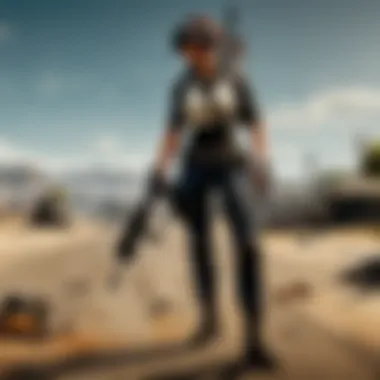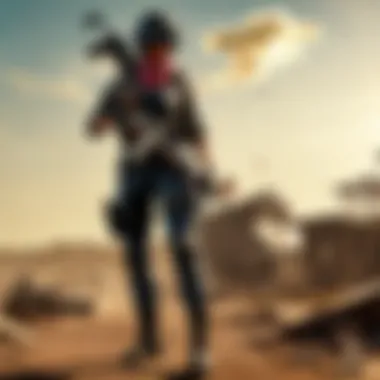Mastering PlayerUnknown's Battlegrounds: A Detailed Guide


Intro
In the fast-paced and tension-soaked world of PlayerUnknown's Battlegrounds, or PUBG, players engage in a fierce battle for survival. Each match unfolds on sprawling maps where 100 competitors drop in, scavenging for weapons and equipment, all while navigating an ever-shrinking battlefield. This guide lays a thorough groundwork for understanding the many layers that make PUBG both complex and rewarding. From the latest game updates that influence mechanics and strategies to the deep-seated community dynamics that drive player engagement, every aspect is essential for anyone who wants to thrive in this volatile landscape.
Grasping PUBG's intricacies can feel daunting, especially with frequent updates reshaping the game's environment and strategies. Effective play hinges on understanding not just the basics but also how to adapt to new challenges and opportunities as they arise. Whether you’re a newcomer looking to get your footing or a seasoned player aiming to sharpen your skills, having a roadmap of what to expect can dramatically improve your gameplay experience.
Throughout this guide, we will discuss significant changes with each update, break down strategies tailored for various maps, and highlight key tactics that can elevate your chances of securing that coveted Chicken Dinner. As we delve into each topic, you will discover that a blend of knowledge and practice is the winning formula in PUBG. Our aim is to provide you with insights that go beyond the surface, equipping you with the tools to navigate and dominate in this game that continuously evolves.
Preface to PlayerUnknown's Battlegrounds
PlayerUnknown's Battlegrounds, commonly known as PUBG, stands as a cornerstone in the world of battle royale gaming. Understanding PUBG is crucial not just for gameplay improvement, but also for comprehending the broader impact it has had on the industry. Starting from its unique mechanics to its competitive nature, PUBG reshaped how players engage with multiplayer titles. It is not merely a game; it’s a community that fosters strategy, teamwork, resilience, and adaptability.
Historical Context
To appreciate the game fully, one must delve into its origins. PUBG emerged from the idea of creating a game mode inspired by the popular Japanese film "Battle Royale". Brendan Greene, known as PlayerUnknown, had initially developed mods for other games before launching PUBG in 2017. The game was groundbreaking, laying the groundwork for the current genre that pits players against each other in a survival-of-the-fittest scenario.
The influence of PUBG can be seen in titles like Fortnite and Apex Legends, which incorporated battle royale elements, yet each has its flavor. PUBG focused on realism, strategic play, and a more serious tone, contrasting with the vibrant, fast-paced nature of its counterparts. This historical backdrop highlights PUBG’s profound contribution to the gaming landscape and its role in popularizing the genre globally.
Game Concept and Design
The concept of PUBG is deceptively simple yet intricately executed. Players start each match by parachuting from a plane onto a vast map, scavenging for weapons, gear, and supplies. The shrinking play zone creates intensity, compelling players to move towards conflict continually. This design amplifies the stakes and encourages dynamic interactions.
The developers embraced a philosophy of "survive first, shoot later." Players quickly learn that strategy often outweighs brute force. Various elements such as terrain, weather conditions, and map layouts require players to adapt their strategies for each match.
The layout of the maps—Erangel, Sanhok, and Vikendi—provides unique environments that dictate player movements and combat choices. For example, Erangel offers an open battlefield ripe for ambushes, while Sanhok, being smaller and dense with cover, promotes fast-paced skirmishes. In this way, the game not only tests reflexes but also strategic foresight, as players must constantly adjust to the evolving battlefield.
Understanding these aspects of PUBG enlightens new players on how to approach the game and allows veterans to refine their strategies further. As the game evolves, so too does the necessity to stay informed about changes in gameplay mechanics, map details, and community trends. Articulating these components fosters a richer gaming experience, enabling players to thrive in one of the most competitive arenas in modern gaming.
Game Mechanics
Understanding the intricacies of game mechanics is pivotal for any player aiming to excel in PlayerUnknown's Battlegrounds. Game mechanics serve as the backbone of gameplay, providing structure and defining how players interact with the game environment. This section delves into basic controls, movement, navigation, and the combat system—elements that together create a rich, immersive experience crucial for both casual and competitive play.
Basic Controls and Interface
The controls in PUBG are designed to be accessible yet deep enough to allow for skilled play. Familiarizing oneself with the layout is essential. For example, the default keybindings are intended to balance ease of use with responsiveness. Players often use movements such as crouching and jumping, which can be the difference between evading a bullet or becoming another statistic.
The interface also plays a crucial role in gameplay, providing critical information such as health status and ammunition count. A cluttered screen can hinder performance, so players are encouraged to customize their HUD for a clearer view of vital elements. Moreover, understanding how to navigate the inventory quickly can vastly improve survivability when under pressure.
Movement and Navigation
Movement in PUBG isn't just about running from point A to point B; it’s about making calculated decisions that could mean life or death. Players can traverse the map by walking, running, or using vehicles, with each method having its pros and cons.
- Walking allows players to move silently, giving them a stealth advantage.
- Running, while faster, can attract attention due to noise.
- Vehicles provide quick escape routes but can be heard from a distance, alerting enemies.
Navigational skills are often what separate the top players from the rest. Familiarity with the terrain, including high ground advantages and choke points, is imperative. Players should also be mindful of the ever-shrinking play zone, which adds another layer of urgency to the movement strategy.
Combat System
The combat system in PUBG is arguably the most complex and engaging aspect of the game, and mastering it can greatly influence match outcomes.
Weapon Types and Characteristics
Weapons in PUBG are classified into various categories, each with unique characteristics that will have a direct impact on combat effectiveness. For instance, assault rifles like the M416 are favored for their balance of fire rate, damage, and versatility.
- Shotguns, on the other hand, can dominate in close quarters, making them a solid choice for players who prefer a more aggressive playstyle.
- Sniper rifles, such as the AWM, excel in long-range combat, rewarding precision and patience.
The choice of weapon often reflects personal playstyle, with some players opting for rapid-fire options while others prefer the quiet lethality of a suppressed sniper. Each firearm’s unique mechanics, such as reload speeds and bullet drop, further enriches the tactical possibilities in combat encounters.


Ammo Management
Managing ammunition efficiently is as crucial as hitting your target. Players need to strike a balance between carrying enough ammo to sustain a firefight and not overloading themselves, which could slow mobility.
Different weapons require different ammo types, and understanding which ammo to prioritize can make all the difference. For example, while 5.56mm rounds are common in many assault rifles, they may not be as numerous in supply crates as 7.62mm rounds found in sniper rifles. This scarcity leads players to decide whether to engage in intense firefights or to strategize based on their ammunition inventory.
Recoil Patterns
Every weapon in PUBG has a unique recoil pattern that can significantly affect shooting accuracy during prolonged engagements. Players who master their weapon's recoil behave more like sharpshooters, adapting quickly to overcome their weapon's kickback.
Certain guns, like the M249, possess a substantial recoil that requires practiced control, while others, like the SCAR-L, might feel more manageable. Understanding these patterns isn't just about familiarity; it directly impacts hit probability and, by extension, survival rates during encounters. Learning and adapting to these patterns enables players to unleash precise bursts of fire, maintaining a strategic upper hand over opponents.
Ultimately, mastering game mechanics is all about practice and understanding. It's not merely about survival; it’s about thriving in a chaotic battlefield where split-second decisions can lead to victory or defeat.
In this complex world of PlayerUnknown's Battlegrounds, honing these gameplay aspects demands persistent effort. As players develop their skills, they begin to recognize that each match presents unique situations, encouraging strategic thinking and adaptability as fundamental components of gameplay.
Maps and Environments
The realm of PlayerUnknown's Battlegrounds thrives on diverse maps and environments, each contributing distinct elements to gameplay. Understanding these spaces is critical for players, as they not only dictate strategy but also influence the overall experience within the game. Maps serve as the stages where battles unfold, offering varied terrain, vantage points, and hiding spots. This section will delve into the available maps, exploring their unique features and how they shape player interactions.
Overview of Available Maps
PUBG has rolled out several maps, each designed with distinct ecosystems and challenges that influence player decisions. Here's a closer look at the prominent maps:
Erangel
Erangel is the original battleground that helped define PUBG. It's a mix of urban cities and vast wilderness, with plenty of buildings to scavenge and cover spots to take a defensive stand. One key characteristic of Erangel is its balance; it offers open fields along with dense clusters of buildings. This blend makes it a favorite among both new and seasoned players as it caters to various play styles. The unique feature of Erangel is the underground bunkers, allowing for strategic positioning and surprise attacks. However, its vastness can also be a disadvantage, as players might find themselves exposed while roaming the open ground.
Sanhok
Sanhok, often referred to as the fast-paced map, is known for its smaller size that encourages more frequent encounters. The vibrant landscape teems with tropical vegetation and diverse environmental features. The map's key characteristic lies in its design—dense foliage coupled with scattered buildings allows for plenty of cover while promoting combat. Sanhok stands out thanks to its dynamic weather changes, which can influence visibility and player tactics. However, the compact nature of Sanhok may leave little room for retreat, making it crucial for players to adopt aggressive strategies cautiously.
Vikendi
Vikendi introduces a snowy atmosphere, offering a stark contrast to the other maps. This map features a blend of open areas and cozy towns, making resource management key as players navigate the wintry conditions. Vikendi’s defining characteristic is visibility, where snow can both conceal and reveal based on one's position and movement. The unique feature lies in the snowmobile vehicles which provide quick transportation across the snowy terrain. On the downside, the snow can reduce visibility while moving, making players easy targets if not cautious.
Karakin
Karakin is distinctive for its arid setting and destructible environments. It emphasizes a tactical approach where players must manage their surroundings effectively, using the terrain to their advantage. A key characteristic of Karakin is the introduction of a demolition feature that allows players to blow up walls and create new pathways. This unique aspect enhances mobility and flanking options, instilling a sense of unpredictability to battles. While this map is favored for its strategic depth, players must stay alert as the open spaces can quickly become deadly under fire.
Unique Terrain Features
Maps like these aren’t just different in aesthetics; they bring unique terrain features that shape gameplay. From urban structures in Erangel to the open fields of Sanhok, each location demands adapting strategies based on environmental factors. Terrain can dictate movement options, sightlines, and ambush opportunities. Knowing when to take cover behind rocks or how the layout allows for sneaky flank attacks makes all the difference. As players immerse themselves in these maps, recognizing these features becomes a key pillar of effective gameplay.
"Navigating the diverse landscapes of PUBG is as vital as mastering its mechanics; each map brings its own set of challenges and opportunities."
As players delve deeper into the nuances of each map, skilled tactics, and knowledge of terrain can turn the tide in a match, elevating the experience to strategic heights. Understanding these landscapes not only enhances survival chances but also enriches the overall gameplay narrative.
Strategies for Success
In PlayerUnknown's Battlegrounds, mastering the game goes beyond just knowing how to shoot or where to land. Having successful strategies can turn a mediocre player into a formidable opponent. The importance of strategies in PUBG can't be overstated; they serve as the backbone to navigating the chaos of battle royale. Getting a grasp on the various phases of the game—early, mid, and end stages—allows players to focus on adapting to ever-changing scenarios and positions.
Early Game Approaches
The early game is a crucial phase where decisions made can significantly impact the outcome of the match. The first steps after jumping from the plane set the tone for the entire experience. A common pitfall is landing directly in high-traffic areas. Instead, scouting for quieter spots can be beneficial. Players should look for buildings that provide adequate loot while also offering cover from potential ambushes.
When players first hit the ground, prioritizing loot is essential. The more gear a player can find quickly—especially weapons, helmets, and armor—the better their chances of surviving the mid-game. A good bit of advice is to gather a reasonable amount of ammunition and health items, even if it might seem like overkill at the time.


- Coordinate with teammates: Communication during this phase can differentiate a successful team from a defeated one. Using voice chat for rapid updates on loot findings can enhance planning.
- Map awareness: Familiarity with the map allows players to execute better decisions. Knowing where the next safe zone is before the blue zone closes can give players ample time to reposition, especially when avoiding confrontations.
Mid-Game Tactics
As players transition into the mid-game, the stakes begin to rise. The focus shifts slightly from looting to survival and positioning. This phase is where you’ll often begin encountering other players. At this point, tactics become favorably more aggressive or defensive, depending on the team's setup and remaining situational strength.
- Positioning is key: Finding a high point on the map can provide players with a bird’s-eye view of the surroundings. Keeping a lookout for moving enemies allows players to decide whether to engage or avoid conflicts based on the situation.
- Utility usage: Throwables like grenades or smoke bombs can shift the tide of battle when utilized effectively. Using smoke to obscure vision during a reposition or to revive a downed teammate can make all the difference.
- Team dynamics: Sticking together helps players cover each other efficiently. If a teammate is downed, valuable attention should be paid to their last known position to plan a safe extraction.
End-Game Decision Making
The end-game is where only the best survival instincts come into play. At this stage, every decision counts heavily. Players often wrestle with anxiety as the safe zone shrinks, increasing both the number of encounters and the tension.
- Stay calm and collected: A crucial tactic is to remain composed when under pressure. Avoiding rushed decisions can prevent detrimental mistakes. Calculating the next moves before engaging can turn the tides successfully.
- Know when to engage or disengage: This is vital in end-game scenarios. If a fight breaks out, consider whether participating will benefit your team's ultimate goal. Sometimes fleeing to an advantageous position may be more effective than continuing a firefight.
- Final circle strategies: Utilizing the terrain and buildings is paramount. Players should scout for the highest positions or buildings with good windows for visibility. This can enhance the ability to catch enemies off guard.
Team Dynamics and Communication
In PlayerUnknown's Battlegrounds, teamwork can often mean the difference between victory and defeat. Understanding team dynamics and communication strategies is fundamental for players aiming to improve their performance in various game modes. Cooperation among teammates not only enhances individual gameplay but also fosters a stronger, more resilient squad. The synergy created through effective team interaction can often outshine mere individual skill. In the fast-paced environment of PUBG, a cohesive team is like a well-oiled machine, ready to tackle challenges as they arise.
Roles within the Team
When engaging in a squad match, each player should have a clearly defined role. This does not mean one player is bound to a rigid task but rather it’s about leveraging individual strengths for maximum impact. Some potential roles include:
- Assault: The front-line player who engages enemies directly. Their focus is often on eliminating threats swiftly.
- Support: Providing covering fire and aiding in reviving teammates are key responsibilities. They ensure the team remains operational during firefights.
- Scout: This player takes on the responsibility of gathering intel, exploring new areas, and relaying enemy positions back to the team. Often a key asset in strategizing movement and engagements.
- Sniper: Positioned at a distance, they offer precision fire, picking off threats without exposing themselves to direct combat. This role requires patience and strong positioning.
An effective team blends these roles seamlessly, allowing players to capitalize on their strengths while compensating for any weaknesses.
Effective Communication Strategies
Tactics in PUBG can shift rapidly, making effective communication pivotal for success. Clear, concise communication can prevent misunderstandings and make sure everyone is on the same page. Here are some strategies players can implement:
- Use Voice Chat: It allows for immediate feedback and real-time strategies. While in the heat of battle, quick decisions are necessary, and voice chat can be a game-changer.
- Callouts: Using specific terms for locations on maps helps in avoiding confusion. Instead of saying, "Over there," refer to specific landmarks like school, military base, or farm.
- Ping System: Utilize the in-game ping function to mark enemies or loot. This visual aid is crucial when words might get lost in the chaos.
- Stay Calm: Keeping a level head during intense situations allows for clearer thinking. Avoid shouting orders or panicking; instead, keep responses calm and clear.
"In times of crisis, communication is not just a tool; it’s the lifeline that keeps the team alive."
As players work on these strategies, they build a stronger team dynamic that is capable of adapting to the unpredictable nature of PUBG.
For additional strategies and community discussions surrounding team dynamics in PUBG, consider checking out forums on reddit.com and other gaming hubs.
Ultimately, having a firm grasp on roles and effective communication can pave the way for memorable experiences on the battlefield.
Game Updates and Community Feedback
In the fast-evolving world of PlayerUnknown's Battlegrounds, staying updated with game changes and community insights is crucial for players aspiring to excel. Updates not only reshape gameplay dynamics but also foster community interaction. Keeping a pulse on patch notes, alterations in mechanics, and player feedback can significantly enhance one’s gaming strategy.
Patch Notes and Changes
Every time a new patch drops, it can be akin to a seismic shift in the game. The developers at PUBG Corporation regularly issue patch notes detailing adjustments to gameplay elements, performance enhancements, and bug fixes. This is not just a routine update; it is a lifeline for players trying to maintain their competitive edge.
Significant Changes Listed in Patch Notes:
- Weapons Adjustments: Small tweaks in damage and handling can profoundly impact the mechanics of gunfights. Players must stay informed to adapt their shooting strategies accordingly.
- Map Alterations: Changes to terrain and cover can create new hotspots or danger zones. Knowing this can inform where players might want to land or rotate.
- System Performance Improvements: Updates addressing bugs or enhancing game performance can lead to smoother experiences and reduced lag.
Competitive Scene
In the realm of PlayerUnknown's Battlegrounds, the competitive scene is not merely an element; it is the beating heart of the game, where players put their skills to the test in high-stakes environments. The thrill of competition adds layers of intensity and excitement, fueling the growing global interest in esports. Understanding this scene is essential for any player hoping to elevate their game.
Here, we will delve into the nitty-gritty of tournaments and the organizations that support and drive the PUBG community's competitive landscape.


Overview of Tournaments
Tournaments in PUBG represent an arena where strategies and skills collide. These organized events bring together the best players from around the world to battle it out for supremacy, bragging rights, and, of course, generous prize pools. The lights, cameras, and audience create a spectacle that is both compelling for spectators and nerve-wracking for the participants.
Major Events
When it comes to major events in competitive PUBG, we are talking about production on a grand scale—events like the PUBG Global Championship, where thousands tune in to watch the action unfold.
One significant aspect of these major tournaments is their inclusivity, as they often feature open qualifiers. This means that aspiring players from all walks of life can strive for a spot, making them a breeding ground for new talent.
Additionally, the community engagement at major events creates some unique features. Fans have opportunities to interact with players through meet-and-greets, watch live streams, and share experiences in various forums. However, due to the massive size of these tournaments, it also faces challenges like overwhelming competition for rising stars, who may find it tough to break through the noise.
Esports Organizations
Esports organizations play a pivotal role in the competitive PUBG landscape, acting as the backbone that supports players and facilitates tournaments. Organizations such as FaZe Clan and Team Liquid not only secure funding for teams but also foster team culture and camaraderie among players.
Another key characteristic to note is the infrastructure these organizations provide for teams, including coaching staff, performance analytics, and training facilities. Such advantages undoubtedly contribute to a player's success in competitions. Nonetheless, with the glamorous side comes pressure. Players may feel the weight of expectations from fans and sponsors alike, which can be burdensome and impact performance on the big stage.
Player Profiles and Teams
To truly appreciate the competitive scene, one must look at the players themselves. Profiles and stories of teams that have risen to stardom often tell tales of grit, strategy, and perseverance. Teams such as Gen.G and Cloud9 not only have unique playstyles but also distinctive personalities that fans rally around. The success of these teams creates a ripple effect, inspiring a new generation of gamers.
Moreover, understanding players’ backgrounds and their path to success illuminates strategies and choices made along the way. Individual player skill sets often shape team dynamics and can contribute significantly to their overall performance in tournaments. Future advancements in player training and mental preparation will likely continue to evolve, pushing the boundaries of what we expect from competitive PUBG.
In summary, the competitive aspect of PUBG is a dynamic ecosystem where talent meets opportunity, and the future looks vibrant with endless possibilities.
Resources for Improvement
Improving in PlayerUnknown's Battlegrounds (PUBG) is a journey, not a sprint. For most players, this means leaning on various resources for guidance. Accessing the right tutorials and engaging with online communities can significantly refine your gameplay experience. A wealth of information exists, but knowing where to look is key. By diving into tutorials designed for different skill levels and participating in forums, players can absorb not just knowledge but also the collective wisdom of the gaming community.
Tutorials and Guides
When it comes to resources, tutorials and guides stand out as invaluable aids. Dive into YouTube or Twitch, and you’ll find a plethora of content showcasing advanced techniques ranging from shooting finesse to tactical gameplay maneuvers. Websites like GamePressure and IGN provide extensive written guides that break down aspects of gameplay systematically.
- Video Tutorials: Watching seasoned players navigate maps or demonstrate specific combat techniques provides a visual learning experience that can be more effective than reading alone.
- Hands-On Guides: Guides detailing specific aspects, whether it’s looting strategies or loadout recommendations, often give step-by-step instructions that can be especially useful for beginners.
- User Reviews: Engaging with community-created content on platforms like Reddit (e.g., r/PUBG) can yield insights into how others have tackled challenges, crafted strategies, and improved their skills over time.
An interesting note is that many tutorials emphasize practice regimens, suggesting that players dedicate certain sessions to honing specific aspects of their game. For instance, focusing an hour on just aiming, things like adjusting sensitivity can lead to costly mistakes in heated moments.
Online Communities and Forums
Online communities and forums are the lifeblood of any game like PUBG. Players share tips, tricks, and experiences that continually elevate the overall knowledge base of the community. These spaces allow for a communal approach to growth and learning. Websites like Reddit or official PUBG forums become hotbeds for discussion where veterans often share their latest strategies or memes that highlight common mistakes among players.
- Collaboration: Participating in forums means exposure to diverse playstyles and strategies. Engaging in discussion threads can provide unique perspectives that alter how one may approach a match.
- Accountability: Building relationships within these communities fosters a sense of accountability. When players share their goals to rank up or master a particular weapon, they are more likely to follow through when they have peers cheering them on.
- Feedback: Submitting gameplay clips on forums for constructive criticism can yield tips that players might not have considered. Whether it’s identifying poor positioning or making suggestions on loadouts, outside eyes can reflect what a player often overlooks.
In summary, the resources for improvement in PUBG are vast and varied. Combining the knowledge gleaned from tutorials with active participation in online communities provides a solid framework for players aspiring to elevate their gameplay. After all, why go it alone when a world of knowledge is just a click away?
"A good player learns from their own mistakes. A great player learns from the mistakes of others."
The Future of PUBG
As PlayerUnknown's Battlegrounds continues to evolve, understanding its future becomes crucial for both avid players and casual enthusiasts. This section delves into the anticipated changes and developments that could shape the game's trajectory. By breaking down potential advancements in gameplay mechanics, visuals, and community engagement, we can gain insight into what lies ahead for PUBG.
The gaming landscape is never static. With emerging technologies and shifting player expectations, PUBG must adapt or risk losing its foothold in a saturated market. Here, we examine several core elements shaping the future of this iconic battle royale game.
Anticipated Developments
The future of PUBG is painted with possibilities that could introduce fresh excitement to the gameplay experience. Some anticipated developments include:
- Enhanced Graphics and Performance Improvements: As technology progresses, players expect more immersive experiences. Future updates could focus on improving graphic fidelity, making environments feel more lifelike and intricate. Optimized performance might lead to smoother gameplay, especially on lower-end devices.
- New Game Modes and Features: Custom game modes have been a hit, allowing players to experiment beyond traditional battle royale. The addition of modes like team deathmatch or capture the flag could cater to community demands for diversity in gameplay.
- Expanded Map Utilization: The world of PUBG has a lot to offer, yet some areas remain underutilized. Greater interaction with the environment, such as dynamic weather affecting gameplay or destructible elements, would significantly enhance strategic depth.
- Integration of AI and Machine Learning: To better tailor experiences, we might see AI-driven systems that adapt to a player’s style. This could manifest in adjusting enemy difficulty levels or providing personalized suggestions for loadouts and strategies.
- Cross-Platform Capabilities: As cross-play becomes a standard expectation across many games, developers may consider enabling it for PUBG. This would boost player bases and reduce matchmaking times by connecting players across different platforms.
The ever-evolving dynamics of gaming mean PUBG's future lies in innovation and responsiveness to player feedback.
Each of these dimensions not only elevates the player experience but also ensures that PUBG remains competitive in the ever-changing gaming landscape. As we look ahead, maintaining an active connection with its community will be paramount in successfully rolling out these advancements.
For more detailed insights and real-time updates, exploring dedicated forums such as reddit.com/r/PUBG can offer players a way to stay informed and engaged with the latest trends and community expectations.



